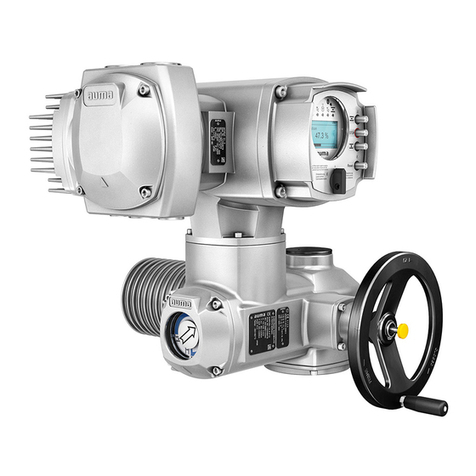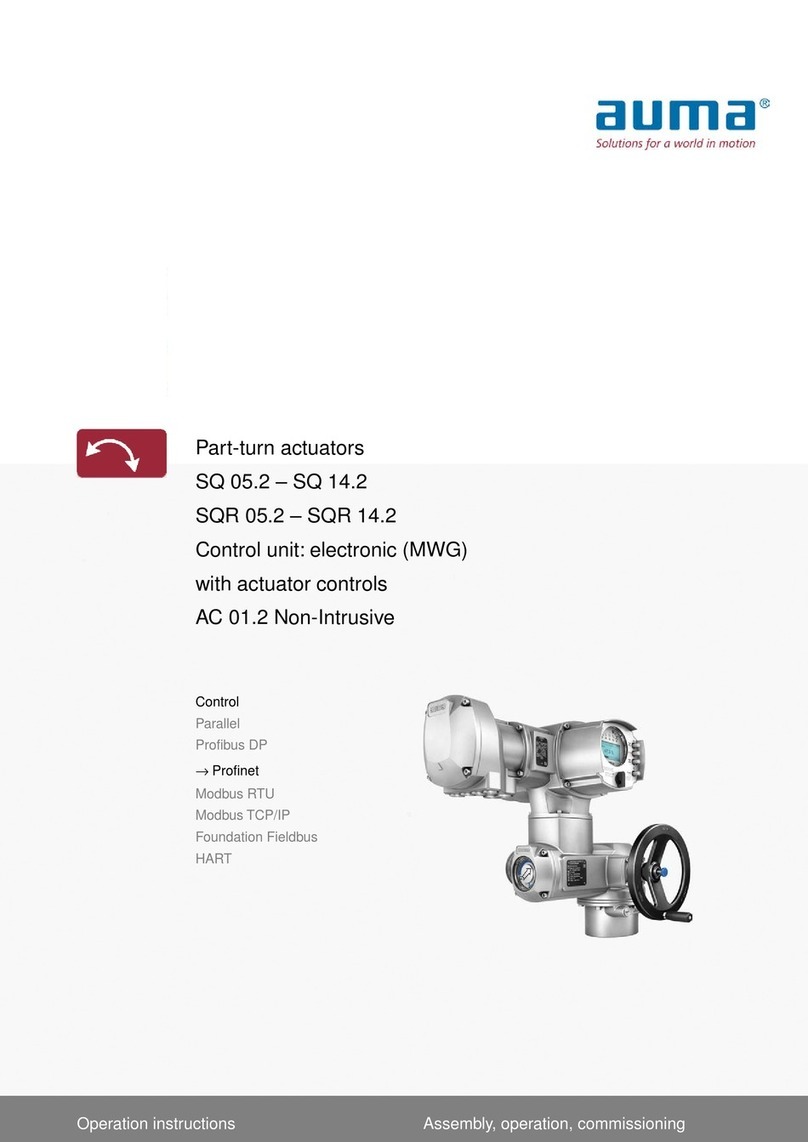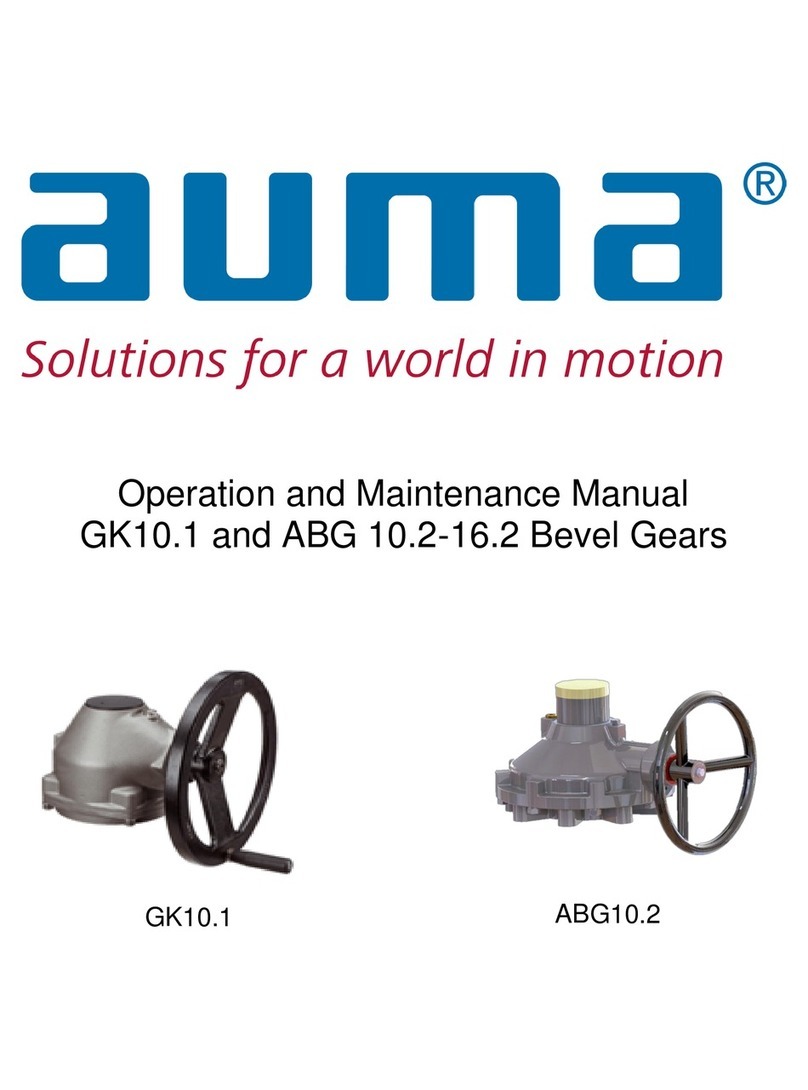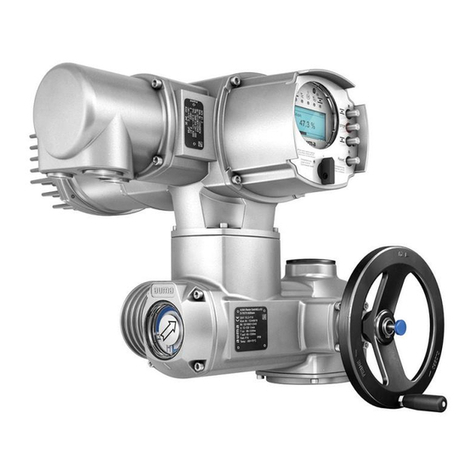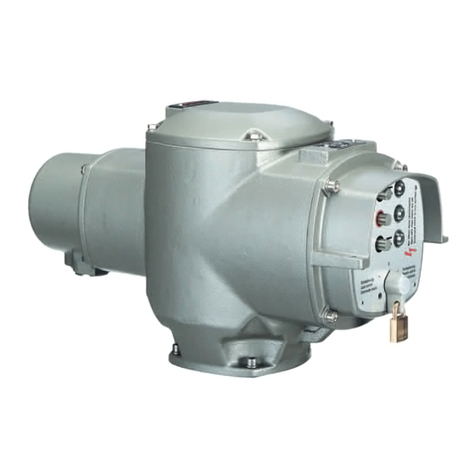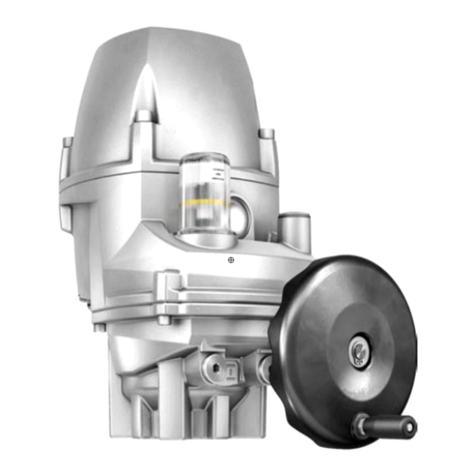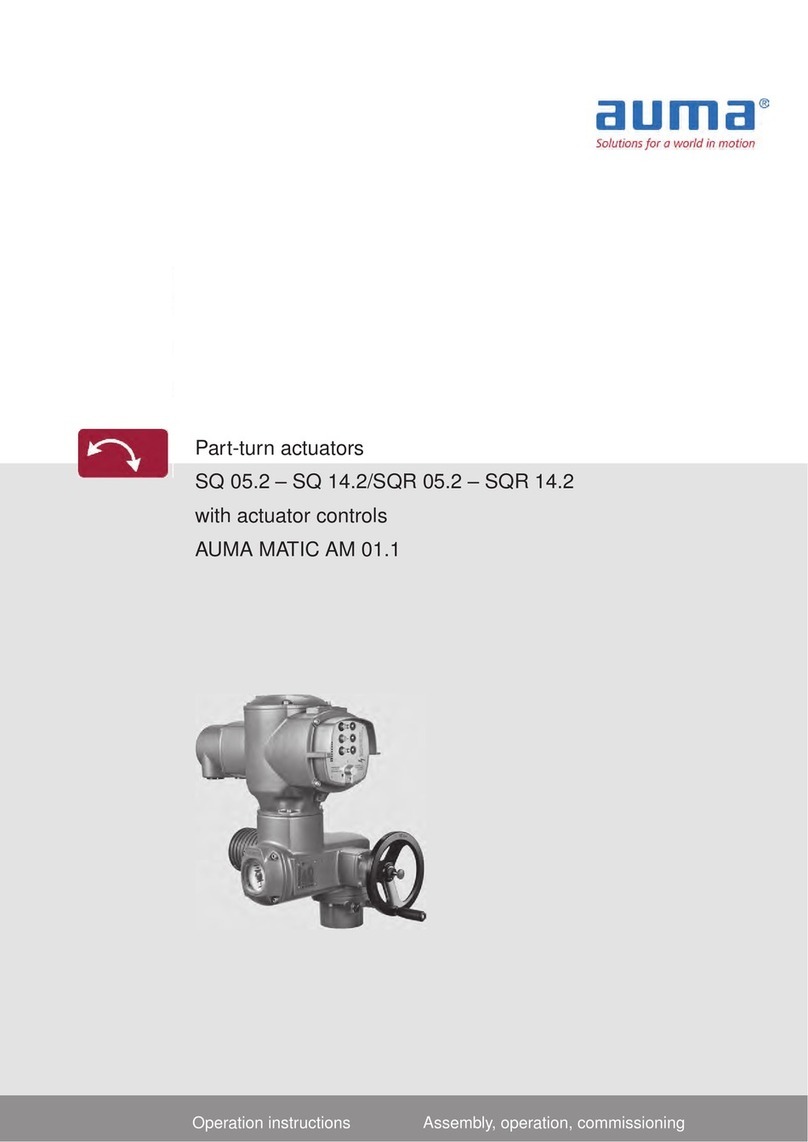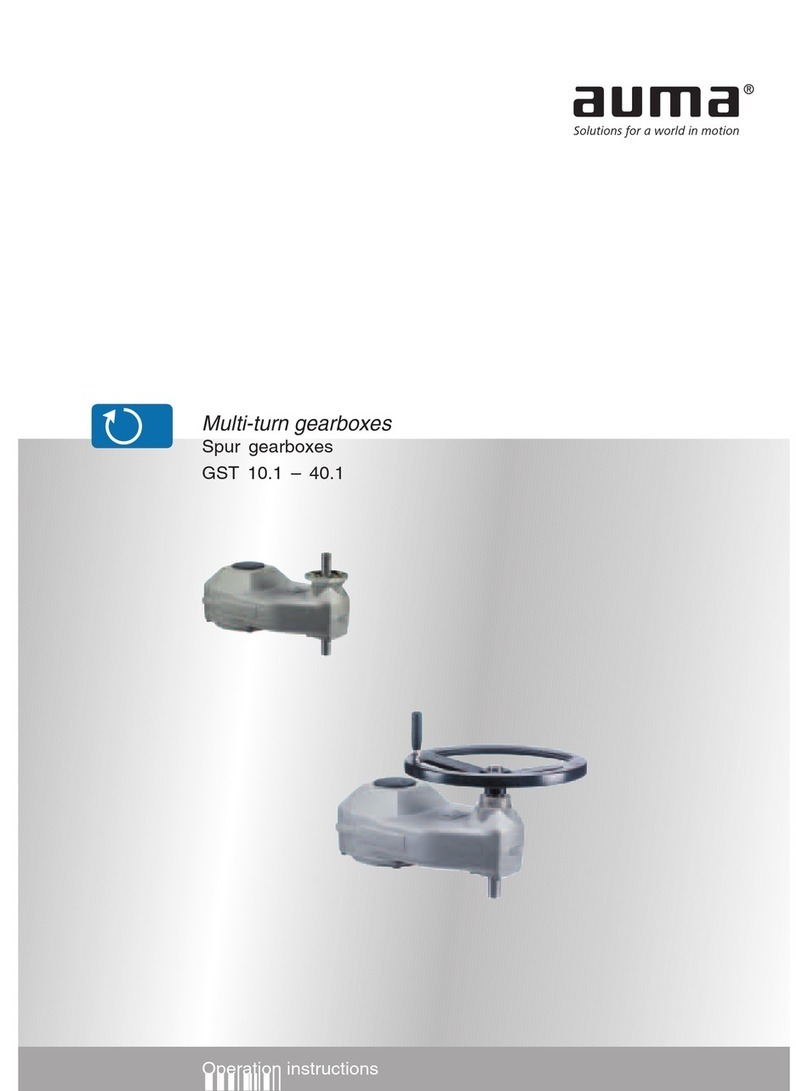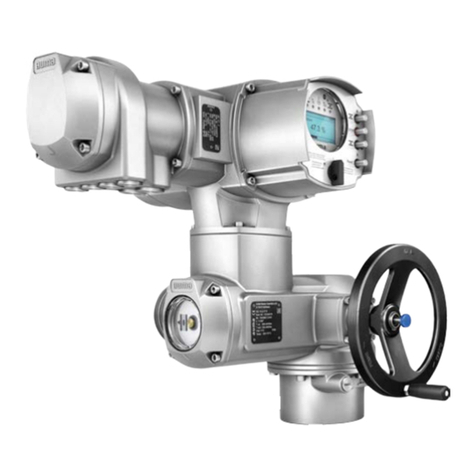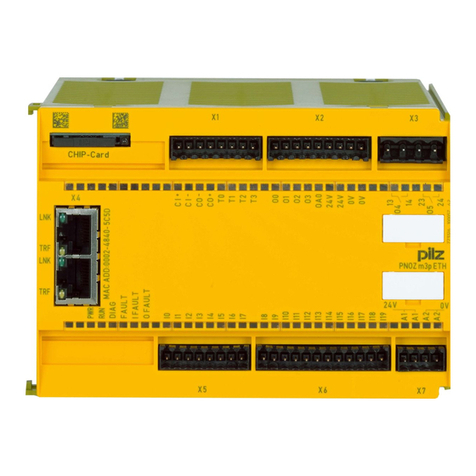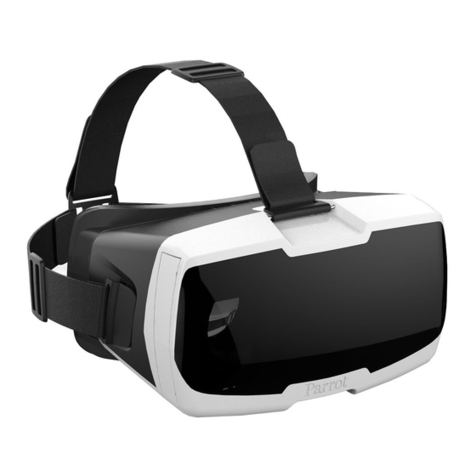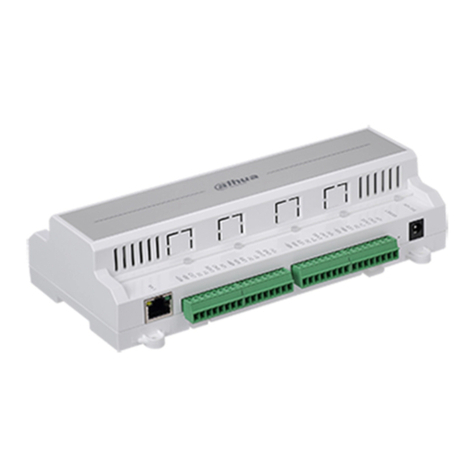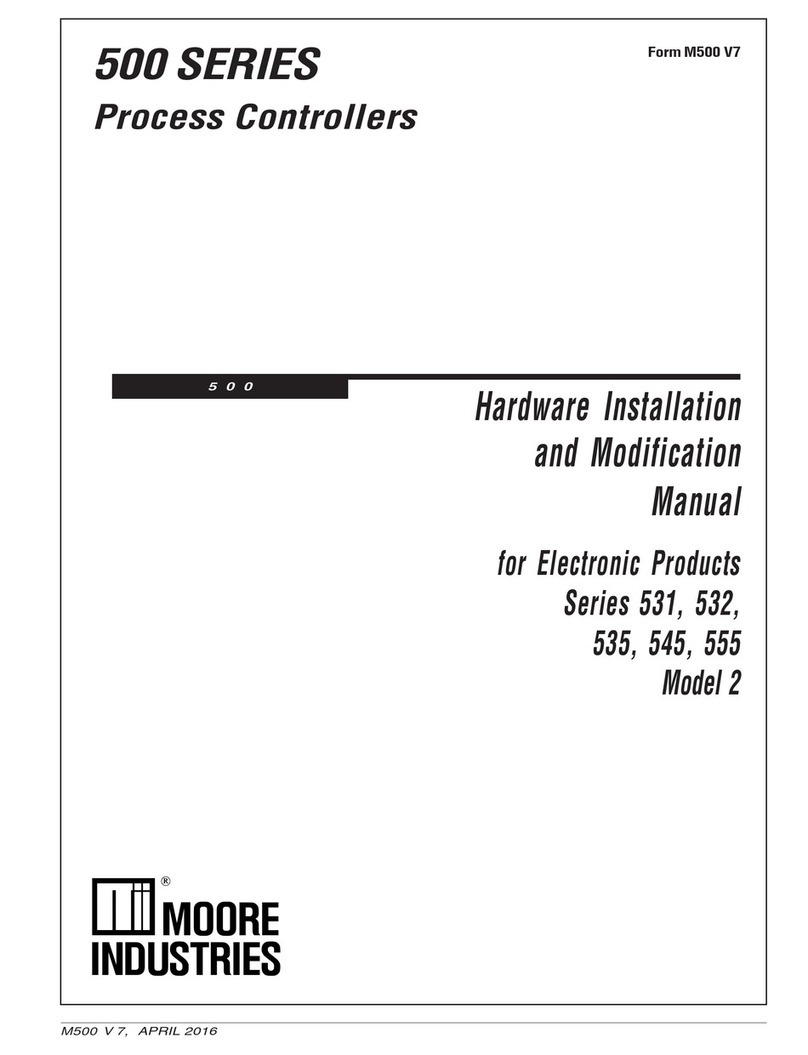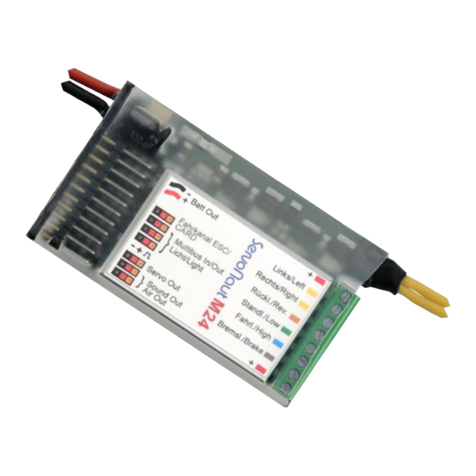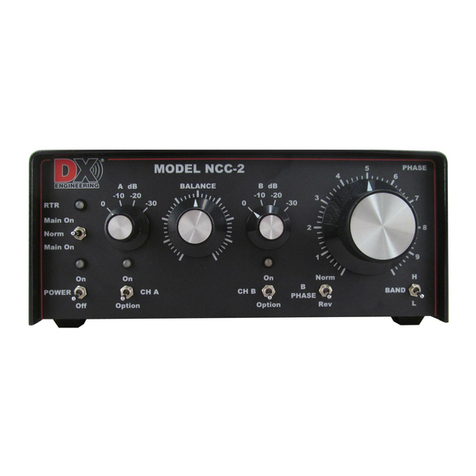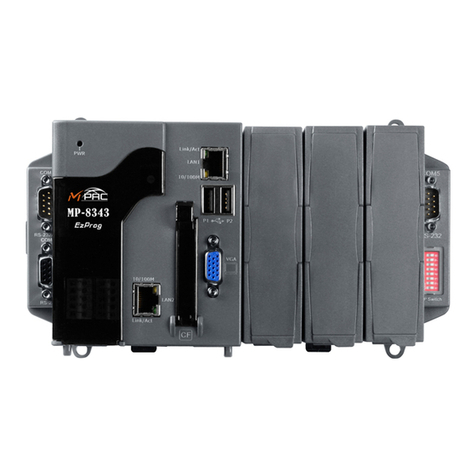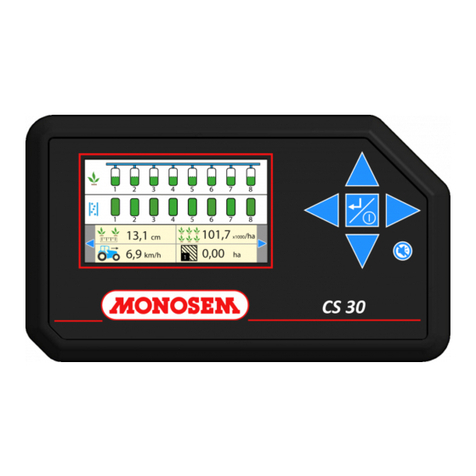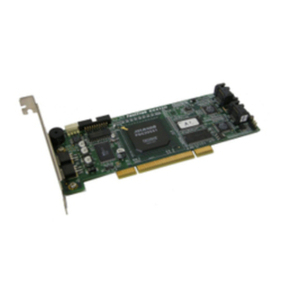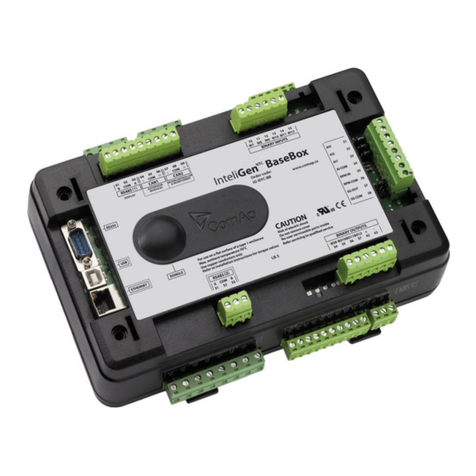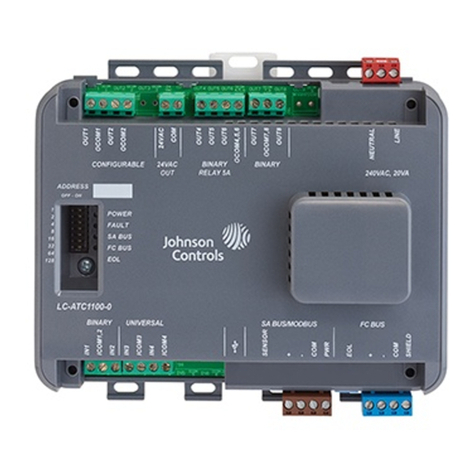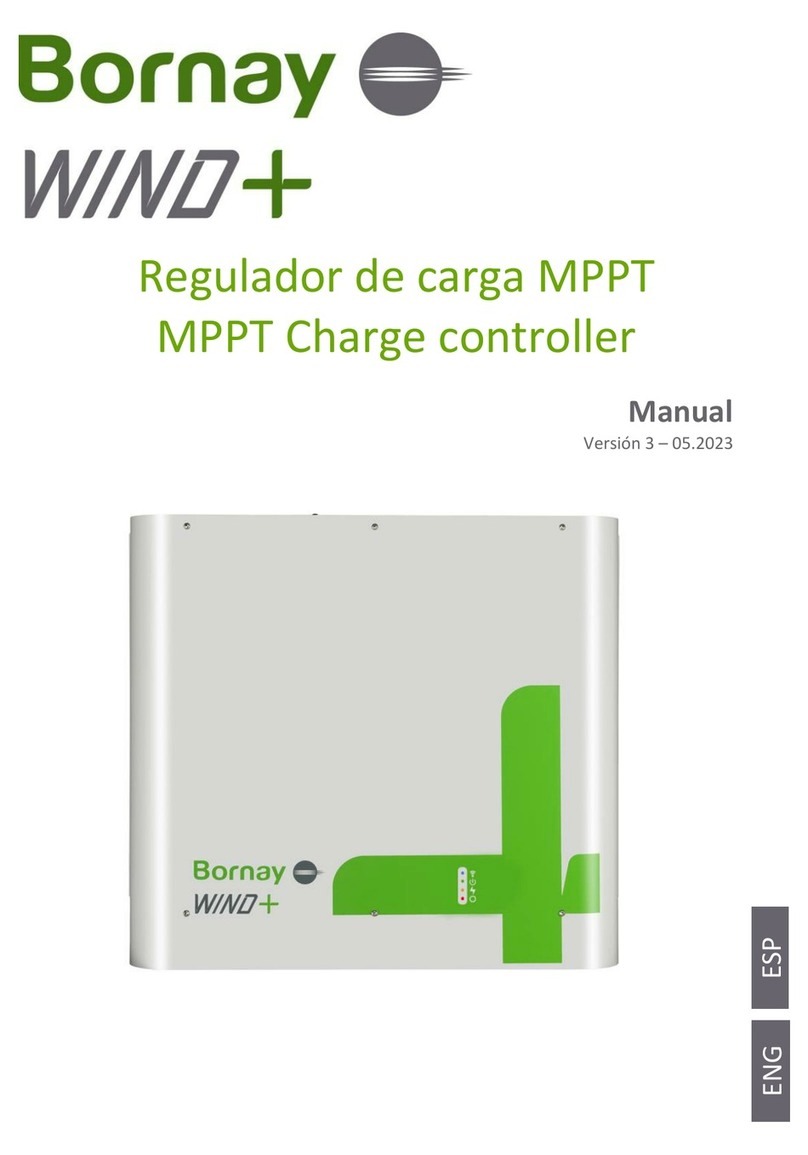AUMA ACE C 01.2 Profinet Series User manual

Actuator controls
AC 01.2/ACExC 01.2
Profinet
Device integrationManual

Read operation instructions first.
●Observe safety instructions.
Purpose of the document:
This document contains information for the commissioning staff of the distributed control system and DCS software
engineers.This document is intended to support actuator integration into the DCS via the communication interface.
Reference documents:
●Operation instructions (Assembly, operation, commissioning) for actuator
●Manual (Operation and setting) AC 01.2 actuator controls Profinet
Reference documents can be downloaded from the Internet (www.auma.com) or ordered directly from AUMA
(refer to <Addresses>).
Table of contents Page
41. Safety instructions................................................................................................................. 41.1. Basic information on safety 41.2. Range of application 51.3. Warnings and notes 51.4. References and symbols
62. General information on Profinet........................................................................................... 62.1. Basic characteristics 72.2. Profinet basic functions 72.3. Communication technology 72.4. Bus access 72.5. Topology –Profinet device network configuration 92.6. Profinet communication cable 102.7. Profinet conformance classes 112.8. Supported functionality 112.9. Protective functions 112.10. Device types
123. Commissioning...................................................................................................................... 123.1. Introduction 123.2. Profinet addressing –device name assignment 133.3. Configuration of Profinet interface 133.4. Communication start 133.5. Communication monitoring 133.5.1. Communication monitoring of Profinet communication 133.5.2. Communication status 143.6. I & M functions
154. Description of the data interface.......................................................................................... 154.1. Input data (process representation input) –signals 154.1.1. Process representation input (default process representation) 174.1.2. Description of the bytes in the process representation input 304.2. Output data (process representation output) 304.2.1. Process representation output arrangement 324.2.2. Description of the output data 374.3. Profinet services 374.4. Redundancy
2
Actuator controls
Table of contents AC 01.2/ACExC 01.2 Profinet

385. Description of Profinet functional module........................................................................... 385.1. Indications (indication and diagnostic LEDs)
406. Corrective action.................................................................................................................... 406.1. Troubleshooting 416.2. Diagnostic
427. Technical data......................................................................................................................... 427.1. Profinet interface
448. Appendix................................................................................................................................. 448.1. Switching example of Profinet 458.2. Parameters
72Index........................................................................................................................................
73Addresses...............................................................................................................................
3
Actuator controls
AC 01.2/ACExC 01.2 Profinet Table of contents

1. Safety instructions
1.1. Basic information on safety
Standards/directives Our products are designed and manufactured in compliance with recognised
standards and directives.This is certified in a Declaration of Incorporation and an
EU Declaration of Conformity.
The end user or the contractor must ensure that all legal requirements, directives,
guidelines, national regulations and recommendations with respect to assembly,
electrical connection, commissioning and operation are met at the place of installation.
Safetyinstructions/warn-
ings All personnel working with this device must be familiar with the safety and warning
instructions in this manual and observe the instructions given. Safety instructions
and warning signs on the device must be observed to avoid personal injury or property
damage.
Qualification of staff Assembly, electrical connection, commissioning, operation, and maintenance must
be carried out by suitably qualified personnel authorised by the end user or contractor
of the plant only.
Prior to working on this product, the staff must have thoroughly read and understood
these instructions and, furthermore, know and observe officially recognised rules
regarding occupational health and safety.
Commissioning Prior to commissioning, it is important to check that all settings meet the requirements
of the application. Incorrect settings might present a danger to the application, e.g.
cause damage to the valve or the installation.The manufacturer will not be held
liable for any consequential damage. Such risk lies entirely with the user.
Operation Prerequisites for safe and smooth operation:
●Correct transport, proper storage, mounting and installation, as well as careful
commissioning.
●Only operate the device if it is in perfect condition while observing these instruc-
tions.
●Immediately report any faults and damage and allow for corrective measures.
●Observe recognised rules for occupational health and safety.
●Observe national regulations.
●During operation,the housingwarmsupandsurfacetemperatures>60 °C may
occur.To prevent possible burns, we recommend checking the surface temper-
ature using an appropriate thermometer and wearing protective gloves, if re-
quired, prior to working on the device.
Protective measures The end user or the contractor are responsible for implementing required protective
measures on site, such as enclosures, barriers, or personal protective equipment
for the staff.
Maintenance To ensure safe device operation, the maintenance instructions included in this manual
must be observed.
Any device modification requires prior written consent of the manufacturer.
1.2. Range of application
AUMA actuator controls are exclusively designed for the operation of AUMA actuators.
Other applications require explicit (written) confirmation by the manufacturer.The
following applications are not permitted, e.g.:
●motor control
●pump control
No liability can be assumed for inappropriate or unintended use.
Observance of these operation instructions is considered as part of the device's
designated use.
4
Actuator controls
Safety instructions AC 01.2/ACExC 01.2 Profinet

1.3. Warnings and notes
The following warnings draw special attention to safety-relevant procedures in these
operation instructions, each marked by the appropriate signal word (DANGER,
WARNING, CAUTION, NOTICE).
Indicates an imminently hazardous situation with a high level of risk. Failure
to observe this warning could result in death or serious injury.
Indicates a potentially hazardous situation with a medium level of risk.Failure
to observe this warning could result in death or serious injury.
Indicates a potentially hazardous situation with a low level of risk. Failure to
observe this warning may result in minor or moderate injury.May also be used
with property damage.
Potentially hazardous situation. Failure to observe this warning may result in
property damage. Is not used for personal injury.
Arrangement and typographic structure of the warnings
Type of hazard and respective source!
Potential consequence(s) in case of non-observance (option)
→Measures to avoid the danger
→Further measure(s)
Safety alert symbol warns of a potential personal injury hazard.
The signal word (here: DANGER) indicates the level of hazard.
1.4. References and symbols
The following references and symbols are used in these instructions:
Information The term Information preceding the text indicates important notes and information.
Symbol for CLOSED (valve closed)
Symbol for OPEN (valve open)
Important information before the next step.This symbol indicates what is required
for the next step or what has to be prepared or observed.
Via the menu to parameter
Describes the path within the menu to the parameter.By using the push buttons of
the local controls you may quickly find the desired parameter in the display.
< > Reference to other sections
Terms in brackets shown above refer to other sections of the document which provide
further information on this topic.These terms are either listed in the index, a heading
or in the table of contents and may easily be located.
5
Actuator controls
AC 01.2/ACExC 01.2 Profinet Safety instructions

2. General information on Profinet
Profinet I/O is a communication protocol for industrial automation engineering based
on Ethernet and standardised by the PROFIBUS Nutzerorganisation e.V.(PNO)
worldwide.Profinet enables real time communication (RT) with short cycle times as
well as acyclic communication (non RT) for configuration and diagnostic.
As communication network for field devices, Profnet reserves many advantages
across the total lifecycle of a site.Advantages include economy in cable connections
and system components as well as simplification of processes within the overall
business environment.
Some of the advantageous Profinet features are:
●Virtually unlimited number of participants within the network
●Flexible topologies (line, star, tree, ring,...)
●Topologies can easily be scaled and expanded
●Network topology can be planned and programmed offline
●Large network expansion by cascading via switches
●High performance (cycle times within the range of 1 –8 ms and high throughput),
in particular for large data volumes (diagnostic, file transfer, etc.)
●Easy device replacement without requirement of new bus configuration
●Simple maintenance
●Use of available networks and IT know-how
●Seamless and vertical integration of process and production data from field
level into the cross-functional information systems
●Simple access to device data on field level without proprietary gateways
●Integration of web servers or universal interfaces such as OPC UA within the
device
●Multitude of network components, software tools and safety technologies
available
●Combination of various transmission media like copper cables, fibre optic cables
or WLAN
Based on Ethernet and IT protocols, Profinet automatically benefits from the
continuous development thanks to a large number of market competitors.
Consequently, Profinet is a future-proof device communication and protects long-term
investments.
2.1. Basic characteristics
Profinet defines the technical and functional features of a communication system
based on Industrial Ethernet, used for interconnecting distributed digital automation
devices.
Profinet makes the distinction between I/O controller (master) and I/O devices (slave).
Profinet is designed for fast data exchange on field level.Here, central control devices
(PLC or PC) communicate via a fast network with peripheral field devices such as
input devices, output devices, valves, and actuators.
Data exchange among these field devices is based on cyclic communication.The
necessary communication functions are defined by the basic Profinet functions
according to IEC 61158 and IEC 61784.
6
Actuator controls
General information on Profinet AC 01.2/ACExC 01.2 Profinet

Figure 1: Profinet network
A Profinet network comprises at least one I/O controller and one or several I/O
devices. As an option, an I/O device can exchange date with several I/O controllers
(shared input and shared device function). An I/O supervisor is often only available
on a temporary basis for commissioning and programming. In turn, for continuous
diagnostic and status monitoring the I/O supervisor is integral part of a Profinet
installation.
2.2. Profinet basic functions
An I/O controller reads the input information in cyclic intervals from the I/O devices
and writes the output information to the I/O devices. In addition to this cyclic data
transfer of the process representation, Profinet also provides powerful functions for
diagnostic and commissioning as well as event based alarm treatment in real time.
Data transfer is monitored via the monitoring function at I/O controller and I/O device
level.
2.3. Communication technology
●Full duplex , 100 Mbit/s switched Ethernet (100BASE-TX) IEEE 802.3
●Wiring according to IEC 61784-5-3. Cable with twisted wire pairs for each dir-
ection RX and TX
●Simultaneous communication into both send and receive direction
●Ethernet switches coordinate data transmission and prevent collisions on the
cable.
2.4. Bus access
●Switched Ethernet with flexible priority control, no collision domains, no coordin-
ation of the network access required –all participants have simultaneous access.
●Data exchange in compliance with provider consumer model:The provider (I/O
device) supplies process data to one or several consumers (I/O controllers).
●The maximum number of Profinet I/O devices per network depends on the I/O
controller implemented.
2.5. Topology –Profinet device network configuration
Profinet is characterised by the virtually free topology implementation.If the required
response times of messages for the automation application are exceeded, the
maximum network depth –the number of cascaded Profinet participants –have been
reached.The maximum distance between two network participants is 100 metres.
7
Actuator controls
AC 01.2/ACExC 01.2 Profinet General information on Profinet

When using switches with fibre optic cable communication, distances can be
increased.
Only use industrial switches certified for Profinet and logically separate the Profinet
based automation network from the remaining IT infrastructure. In general, hubs
may not beused since this couldlead to networkcollision.Basedon existing network
load by office applications, uncoordinated mixing of office network and automation
network can lead to unpredictable problems with the Profinet application.For Profinet
networks as of conformity class CC-B, both points specified are binding.
The following topologies and combinations are possible using Profinet:
Point-to-point or start
topology Devices in this topology only have one connection to the DCS (point-to-point) or to
the Ethernet switch (star).
Figure 2: Point-to-point or start topology
Line topology With this topology, devices and DCS are interconnected in series.To connect the
devices, no additional Ethernet switch is required
Figure 3: Line topology
Tree topology If you interconnect several star structures, you obtain a tree network topology. Any
combination is possible
8
Actuator controls
General information on Profinet AC 01.2/ACExC 01.2 Profinet

Figure 4:Tree topology
Ring topology When applying this topology, the devices and the DCS are connected in series.The
major difference to line topology is that both the first and the last device are connected
to the DCS.The ring topology is recommended when redundancy structures are
required. However, make sure that this topology is supported by the DCS.
Figure 5: Ring topology
2.6. Profinet communication cable
According to IEC 61156-6, CAT 5 cables are specified as minimum requirement for
Profinet. However using CAT 5e and CAT 6 cables is recommended.For further
references regarding planning an installation of Profinet networks, the PROFIBUS
User Organisation (PUN) provides suitable guidelines.
The following tables list the available cable types Profinet types A through C with
regard to the respective application:
9
Actuator controls
AC 01.2/ACExC 01.2 Profinet General information on Profinet

Table 1:
Cable types for dual pair Profinet cables
Application type CApplication type BApplication type ACable types
Dual pair data cableDual pair data cableDual pair data cableVersion
special applications (e.g.for con-
tinuous movement, vibration or
twisting)
flexible installation (e.g.for continu-
ous movement, vibration or twist-
ing after installation)
fixed installation, immobile after
installation
Type of installation
Cable parameter
"PROFINET type C""PROFINET type B""PROFINET type A"Designation (minimum)
AWG 22/.. ≥0.318 mm²AWG 22/7 ≥0.318 mm²AWG 22/1 ≥0.610 mm²
Cross section
depending on the application5.5 –8.0 mmOuter cable diameter
depending on the application
1.4 ±0.2 mm
Wire diameter
depending on the applicationGreen RAL6018Colour of shield
Pair 1: white, blue
Pair 2: yellow, orange
Colour of wire insulation
4Number of wires
Dual pair or star quadCable design
depending on the applicationAluminium foil + copper braidShield
Communication requirements
ISO/IEC 11801 Edition 2.0
IEC 61140-1
IEC 61156-6
(minimum device group 5)
ISO/IEC 11801 Edition 2.0
IEC 61140-1
IEC 61156-5
(minimum device group 5)
Applicable standards
≦20 ns/100 m
Delay
≥80 dB at 30 –100 MHz
"Channel class-D" according to EN 50174-2
Coupling attenuation
Minimum cable spacing The minimum spacing (according to IEC 61918) required between laying Profinet
cables and other cables must be respected.They are shown in the table below.
Table 2:
Minimum spacing for Profinet cables
Spacing to Profinet cable
Steel cutoff bridgeAluminium cutoff bridgeWithout or with non-metal
cutoff bridge
Signal transmission cable
0 mm0 mm0 mmFor example other Profinet cables, Profibus cables, data
cablesforPCs,programmingdevices, shieldedanalogue
inputs
Power supply cables
50 mm100 mm200 mmUnshielded power supply cables
0 mm0 mm0 mmUnshielded power cables
Further references Available Profinet recommendations, particularly planning, assembly and
commissioning guidelines of the PROFIBUS User Organisation (PNO)
(www.profibus.com) must be met.
2.7. Profinet conformance classes
To simply the application of Profinet, various conformance classes are defined which
specifyrequired propertiesof the Profinetcomponents and ensure their interoperability
by certifications.
The main properties of the conformance classes are shown in the table below:
10
Actuator controls
General information on Profinet AC 01.2/ACExC 01.2 Profinet

Table 3:
CC-C (synchronised commu-
nication –IRT) CC-B plus
CC-B (unsynchronised), CC-
A plus
CC-A (unsynchronised)
●Hardware supported band-
width utilisation (IRT com-
munication)
●Synchronisation
●Basis for time synchronised
applications (cycle times
>1ms, jitter <1µs)
●Certified Profinet Switches
●Network diagnostic via IT
mechanisms (SNMP)
●Simple device replace-
ment
●Neighbourhood topology
detection (LLDP with
LLDP-MIB)
●Offline topology configura-
tion possible
●Optional media redund-
ancy CC-B (PA)
●Basic functions for Profinet
I/O with RT communica-
tion
●Standard Ethernet IEEE
802.3 switches
●Cable based
●Wireless data transmis-
sion possible
●TCP/IP communication
(acyclic services)
2.8. Supported functionality
Actuator controls offer the following functionality:
Switch functionality: ●Two Ethernet ports 100BASE-TX with integral Ethernet switch suitable for in-
dustrial applications
●Conformance class CC-C RT class 2, without application synchronisation (RT
class 3)
●Managed Switch Services, SNMP …
●Autonegotiation, crossover and polarity
Device functionality ●Profinet I/O conformance class CC-B(PA) RT class 1
●DCP and DHCP for IP address assignment
●Web server for network configuration and diagnostic
●Acyclic communication: Diagnostic & parametrisation via FDI package
●Support of two simultaneous cyclic communication relations
●Extended device identification in compliance with I&M 1-3
●Profinet I/O version 2.3.2
●GSDML version 2.3.2
●Redundancy according to MRP –ring topology supported
Unsupported functions ●Redundancy according to MRRT or MRPD
●Shared input and shared device
2.9. Protective functions
●Response monitoring (watchdog)
●Access protection for inputs/outputs (sync and freeze)
●Process data exchange (DATA EX) monitoring with configurable timer interval
at controller
●Adjustable failure behaviour at actuator
2.10. Device types
●I/O controller: e.g. central automation devices like PLC
●I/O supervisor: e.g. programming devices or projecting devices (PC)
●I/O device: devices with binary or analogue inputs/outputs,e.g. actuators, ball
and plug valves
●Network components: e.g. switches, access points, router
11
Actuator controls
AC 01.2/ACExC 01.2 Profinet General information on Profinet

3. Commissioning
3.1. Introduction
Only few steps are required to integrate an AUMA actuator into a Profinet
environment.At first, a standardised device description (GSDML file) is linked to the
DCS.The "device name assignment" for the actuator using the DCS system tools
is the next step.On the basis of the device name, the actuator is identified within the
Profinet system.The IP address is automatically assigned by the automation system.
Afterwards, the user can configure and parametrize the device via the programming
software of the DCS used.This information is then stored in the DCS (I/O controller)
and sent to the actuators (I/O devices) each time cyclic communication is started.
The process representation input and output bytes are used to control the actuator
and to supply the feedback signals.If a configuration with consistent data is selected,
certain controllers require special function blocks for controlling the Profinet I/O
devices.
An integrated AUMA web server additionally allows swift and easy performance of
connection tests, status requests and fault diagnostic by means of a web browser.
Certification AUMA actuators with Profinet are certified by the PROFIBUS User Organisation
(PNO).
Identification number
(device type) Each Profinet I/O device and each I/O controller has an individual identification
number.The Ident number is required for the I/O controller to identify the type of
device connected without signification protocol overhead.The controller compares
the Ident numbers of the connected I/O devices to the Ident number in the specified
configuration data.The process data transfer will only be started if the correct device
types with the correct device addresses were connected to the network.This ensures
a high security against configuration errors.The PNO manages the Ident numbers
togetherwith the device master data (GSDML).AUMAactuators with actuator controls
AC 01.2 are logged in the PNO with the following identification numbers:
●Ident no.: 0x0001, manufacturer ID 0x013F
Device Master Data
(GSD/GSDML) For Profinet, the performance features of the devices are documented by the
manufacturer and made available to the users as device data sheet and a General
Station Description in XML format. Structure, contents and coding of the General
station description (GSDML) are standardised.They enable integration of any I/O
device into engineering tools of different manufacturers.
For AUMA actuators equipped with actuator controls, the following GSD file is
available:
GSD file GSDML-V2.32-AUMA-AC01-2-20160810.xml
Profinet I/O version 2.3.2
Manufacturer ID 0x013F = 319 = AUMA Riester GmbH & Co. KG
Device ID 0x0001 = 1 = AUMATIC AC 01.2 /ACExC 01.2
DAP: 0x80010000
Information GSD or GSDML files can be downloaded from our website: www.auma.com.
3.2. Profinet addressing –device name assignment
The device name is assigned to the device during device name assignment.The
acyclic communication is IP based and allows the use of known IT mechanisms via
protocols such as UDP or TCP/IP, while cyclic Profinet real-time data as well as
event-based alarms are exclusively based on the most widely used network
technology, Ethernet with MAC addressing and message prioritisation.The MAC
address is inseparably linked to the device and unique around the world. Using the
DCP protocol (Discovery) and the device name, the controller will identify the network
participants and will assign their IP addresses.As an alternative, the IP address may
also be assigned manually.
12
Actuator controls
Commissioning AC 01.2/ACExC 01.2 Profinet

Profinet participants are therefore addressed by means of the parameters below:
●Unique MAC address
●Assigned device names
●Assigned IP address
Device name and, as an option, also the IP address, is assigned by the software
used for configuration of the network topology, e.g. Siemens Step7/TIA or Proneta
The described address parameters can be read via local display, using the AUMA
CDT service software or any other (e.g. FDI based) configuration and diagnostic
system.
3.3. Configuration of Profinet interface
Configuration of cyclic data transfer is exclusively made via the Profinet controller
which sends the configuration when establishing the cyclic data transfer to the device.
The devices receives the configuration, checks for validity and adapts itself to the
new configuration, provided that it is valid.No settings are made within the device
itself.The configuration procedure depends on the implemented tool.
The number of input and output bytes sent or received by the I/O devices to and
from the controller are predefined within actuator controls.To this end, once the
controller starts cyclic communication, the required communication relations are
negotiated with the I/O device.
3.4. Communication start
After successful device name assignment, the communication channels between
I/O controller and I/O devices are established.The I/O controller creates so-called
Application Relations (AR) between the participants.Communication Relations (CR)
with different properties are defined via these AR:
●Record Data CR for the acyclic parameter transfer
●I/O Data CR for the cyclic process data exchange
●Alarm CR for signalling alarms in real time
With this, all relevant parameters and times for system startup as well as transmission
rates of cyclic I/O data from the I/O controller are transferred to the I/O devices.
After successful establishment of application relations and their communication
relations, the network participants start productive operation.
The Internet Protocol (IP) is used for connection setup and acyclic services.The
Address Resolution Protocol (ARP) is enhanced with the detection of duplicate IP
addresses.The Discovery and basic Configuration Protocol (DCP) is used for IP
address assignation. As an option, DHCP may also be used.
3.5. Communication monitoring
3.5.1. Communication monitoring of Profinet communication
The active Profinet communication is continuously monitored. In case of failure, a
failure behaviour is initiated which can be defined as requested.
3.5.2. Communication status
Correct Profinet communication to the actuator can be checked via local controls
display or via the AUMA CDT service software.The relevant information can be
found in the menu:Diagnostic > Profinet > Communication status > Channel 1 DataEx
and channel 1, or channel 2 activity
●0 = no communication active
●1 = communication
Channel 1 or channel 2 activity describes whether data traffic could be detected on
the respective Ethernet port 1 or port 2 and thus whether a correct network connection
was established. However, data does not have to be directly addressed to actuator
controls.
13
Actuator controls
AC 01.2/ACExC 01.2 Profinet Commissioning

Channel 1 DataEx describes, whether the device can correctly communicate using
one of the two ports and whether the Profinet data has been sent to the device. A
Profinet user relation to I/O controller or I/O supervisor is available.
3.6. I & M functions
The actuator controls support the I & M function according to PNO guideline 3.502.
With the term Identification & Maintenance (I & M) functions, the PROFIBUS User
Organisation (PNO) introduced a new functionality for all Profibus and Profinet devices
with acyclic communication channel that may prove very useful for plant operators.
The I & M functions define how certain device-describing data (according to name
plate) is to be uniformly stored in the Profinet devices. Engineering tools may then
read and interpret the data according to a code which can be accessed on the PNO
server.This providesuniformandpowerfulaccess to all importantand current device
data.This is a significant requirement for Asset Management.
Part of the device-specificI &M information is theunambiguous (asset) identification
using a manufacturer ID (MANUFACTURER_ID, for AUMA actuators = 319), the
order number (ORDER_ID) of the actuator as well as the individual serial number
(SERIAL_NUMBER). Further data supplements the asset information.
Table 4:
DescriptionSizeContentRecord PROFINET I/O Object (F6h), attribute #2
(‘Vendor ID/I&M Vendor ID’)
2 bytesMANUFACTURER_IDI&M0
PROFINET I/O Object (F6h), attribute #8
(‘I&M Order ID’)
20 bytesORDER_ID
PROFINET I/O Object (F6h), attribute #9
(‘I&M Serial Number’)
16 bytesSERIAL_NUMBER
PROFINET I/O Object (F6h), attribute #10
(‘I&M Hardware revision’)
2 bytesHARDWARE_REVI-
SION PROFINET I/O Object (F6h), attribute #11
(‘I&M Software revision’)
4 bytesSOFTWARE_REVI-
SION PROFINET I/O Object (F6h), attribute #12
(‘I&M Revision counter’)
2 bytesREVI-
SION_COUNTER PROFINET I/O Object (F6h), attribute #13
(‘I&M Profile ID’)
2 bytesPROFILE_ID
PROFINET I/O Object (F6h), attribute #14
(‘I&M Profile specific type’)
2 bytesPROFILE_SPECIF-
IC_TYPE 0101h (Internal, constant value)2 bytesIM_VERSION 001Eh (Internal, constant value)2 bytesIM_SUPPORTED Default: All bytes set to blanks (‘‘)32 bytesTAG_FUNCTIONI&M1 Default: All bytes set to blanks (‘‘)22 bytesTAG_LOCATION Default: All bytes set to blanks (‘‘)16 bytesINSTALLA-
TION_DATE
I&M2
Default: All bytes set to blanks (‘‘)54 bytesDESCRIPTORI&M3 Default: All bytes set to zero (00h)54 bytesSIGNATUREI&M4
14
Actuator controls
Commissioning AC 01.2/ACExC 01.2 Profinet

4. Description of the data interface
Cyclic data
Configuration of cyclic data transfer is done via the Profinet controller only.Selection
of the input/channel or the respective input and/or output date is performed via the
slot/subslot configuration used to program a Profinet controller.
All I/O data is provided in slot 1, subslot 1.Data is structured in various blocks with
different properties.The following section comprises explanations about the different
blocks.
Process interface
Data structure is described on the basis of the automation system:
●Input data: Is sent by the field device to the automation system
●Output data: Is sent by the automation system to the field device
4.1. Input data (process representation input) –signals
The consumer (controller) can read the state of the provider (actuator) via the process
representation input..
4.1.1. Process representation input (default process representation)
Grey bits are collective signals.They contain the results of a disjunction (OR
operation) of other information.
Module definition
●Module ID="ID_MODULE_ADI_IN_0
●ModuleIdentNumber="0x00008000"
●ModuleInfo CategoryRef=Input
●Name TextId="Inputs"
●InfoTextTextId="Prozessabbild Input Daten"
Sub-module definition
●VirtualSubmoduleItem ID="ID_SUBMOD_ADI_PAIN_0"
●SubmoduleIdentNumber="0x00002200"
●API="0"
●FixedInSubslots="1"
●Name TextId="Inputs"
●InfoTextTextId="Prozessabbild Input Daten"
I/O data definition in sub-module
●IOData IOPS_Length="1"
●IOCS_Length="1"
●Input Consistency="All items consistency">
15
Actuator controls
AC 01.2/ACExC 01.2 Profinet Description of the data interface

16
Actuator controls
Description of the data interface AC 01.2/ACExC 01.2 Profinet

4.1.2. Description of the bytes in the process representation input
Byte 1: Logic signals
Bits 3, 6, and 7 are collective signals.
Bits 5 and 4 of the logical signals (byte1) indicate a logical operation of the actuator,
i.e.they are set when the actuator has received the command to perform an electrical
operation (also active when e.g.the actuator is in a stepping pause during stepping
mode or waiting for the end of the dead time).
Table 5: Byte 1: Logic signals
DescriptionValuePrm-Text-Def GSD fileDesignation
(process representation)
Bit
For limit seating:Limit switch operated in direction OPEN
For torque seating:Torque switch and limit switch oper-
ated in direction OPEN
1End position OPEN
End position OPEN
0
No signal0 For limit seating: Limit switch operated in direction
CLOSE
For torque seating:Torque switch and limit switch oper-
ated in direction CLOSE
1End position CLOSED
End position CLOSED
1
No signal0
17
Actuator controls
AC 01.2/ACExC 01.2 Profinet Description of the data interface

DescriptionValuePrm-Text-Def GSD fileDesignation
(process representation)
Bit
The position setpoint is within max.error variable (outer
dead band).Is only signalled if Profinet consumer (con-
troller) has set the Fieldbus SETPOINT bit (process
representation output).
1Setpoint reached
Setpoint pos.reached
2
No signal0 Collective signal 04:
Contains the result of a disjunction (OR-operation) of all
bits comprised in bytes 13 and 14 (Not ready REMOTE
1 and Not ready REMOTE 2).
The actuator cannot be operated from REMOTE.
Theactuator can only be operatedvia the local controls.
1Not ready REMOTE
Not ready REMOTE
3
In bytes 13 and 14, no signals are active (all bits are set
to 0).
0
An operation command in direction OPEN is performed
via the communication interface: Fieldbus OPEN or
Fieldbus SETPOINT (process representation output).
This bit remains also set during operation pauses (e.g.
due to the dead time or the reversing prevention time).
1Running OPEN
Running OPEN
4
No operation in direction OPEN is performed via the
communication interface.
0
An operation command in direction CLOSE is performed
via the communication interface: Fieldbus CLOSE or
Fieldbus SETPOINT (process representation output).
This bit remains also set during operation pauses (e.g.
due to the dead time or the reversing prevention time).
1Running CLOSE
Running CLOSE
5
No operation in direction CLOSE is performed via the
communication interface.
0
Collective signal 02:
Contains the result of a disjunction (OR-operation) of all
bits of bytes 17 to 20 (Warning 1 to Warning 4).
1Warnings
Warning
6
In bytes 17 and 20, no warnings are active (all bits are
set to 0).
0
Collective signal 03:
Contains the result of a disjunction (OR-operation) of all
bits of bytes 15 and 16 (Fault 1 and Fault 2).
The actuator cannot be operated.
1Fault
Fault
7
In bytes 15 and 16, no faults are active (all bits are set
to 0).
0
Byte 2: Actuator signals
Table 6: Byte 2: Actuator signals
DescriptionValuePrm-Text-Def GSD fileDesignation
(process representation)
Bit
Motor protection tripped.1Thermal fault
Thermal fault
0No signal0
●When connecting to a 3-phase AC system and with
internal 24 V DC supply of the electronics:Phase 2
is missing.
●Whenconnecting toa 3-phase or 1-phase ACsystem
and with external 24 V DC supply of the electronics:
One of the phases L1, L2 or L3 is missing.
1Phase failure
Phase fault
1
All phases are available.0 Selector switch is in position REMOTE.1Selector switch REMOTE
Selector sw. REMOTE
2Selector switch is not in position REMOTE.0 Selector switch is in position LOCAL.1Selector switch LOCAL
Selector sw. LOCAL
3Selector switch is not in position LOCAL.0
18
Actuator controls
Description of the data interface AC 01.2/ACExC 01.2 Profinet

DescriptionValuePrm-Text-Def GSD fileDesignation
(process representation)
Bit
Limit switch in end position OPEN active.1Limit switch OPEN
Limit switch OPEN
4No signal0 Limit switch in end position CLOSED active.1Limit switch CLOSE
Limit switch CLOSED
5No signal0 Torque switch operated in direction OPEN1Torque switch OPEN
Torque sw. OPEN
6No signal0 Torque switch operated in direction CLOSE1Torque switch CLOSE
Torque sw. CLOSED
7No signal0
Bytes 3 and 4: Actual position
Byte 3 = high byte, byte 4 = low byte.
If a position transmitter (potentiometer, RWG, EWG, or MWG) is installed in the
actuator, bytes 3 and 4 are used to transmit the current actuator position.The value
is transmitted in per mil (value: 0 –1,000).
Byte 5: Device status
Table 7: Byte 5: Device status
DescriptionValuePrm-Text-Def GSD fileDesignation
(process representation)
Bit
Collective signal 04:
Contains the result of a disjunction (OR-operation) of all
bits comprised in bytes 13 and 14 (Not ready REMOTE
1 and Not ready REMOTE 2).
The actuator cannot be operated from REMOTE.
The actuator can only be operated via the local controls.
1Not ready REMOTE
Not ready REMOTE
0
In bytes 13 and 14, no signals are active (all bits are set
to 0).
0
Collective signal 02:
Contains the result of a disjunction (OR-operation) of all
bits of bytes 17 to 20 (Warning 1 to Warning 4).
1Warnings
Warning
1
In bytes 17 and 20, no warnings are active (all bits are
set to 0).
0
Collective signal 03:
Contains the result of a disjunction (OR-operation) of all
bits of bytes 15 and 16 (Fault 1 and Fault 2).
The actuator cannot be operated.
1Fault
Fault
2
In bytes 15 and 16, no faults are active (all bits are set to
0).
0
Collective signal 09:
Indication according to NAMUR recommendation NE 107
Recommendation to perform maintenance.
Contains the result of a disjunction (OR-operation) of all
bits of byte 24 (Maintenance required).
1Maintenance required
NAMUR mainten. req.
3
In all bits of byte 24, no signals are active (all bits are set
to 0).
0
Collective signal 07:
Indication according to NAMUR recommendation NE 107
Actuator is operated outside the normal operation condi-
tions.
Contains the result of a disjunction (OR-operation) of all
bits of bytes 25 to 28 (Out of specification 1 to 4).
1Out of specification
NAMUR out of spec.
4
In bytes 25 and 28, no signals are active (all bits are set
to 0).
0
19
Actuator controls
AC 01.2/ACExC 01.2 Profinet Description of the data interface

DescriptionValuePrm-Text-Def GSD fileDesignation
(process representation)
Bit
Collective signal 08:
Indication according to NAMUR recommendation NE 107
The actuator is being worked on;output signals are tem-
porarily invalid.
Contains the result of a disjunction (OR-operation) of all
bits of bytes 29 and 30 (Function check 1 and 2).
1Function check
NAMUR funct. check
5
In bytes 29 and 30, no signals are active (all bits are set
to 0).
0
Collective signal 10:
Indication according to NAMUR recommendation NE 107
Actuator function failure, output signals are invalid.
Contains the result of a disjunction (OR-operation) of all
bits of byte 23 (Failure).
1Failure
NAMUR failure
6
In all bits of byte 23, no signals are active (all bits are set
to 0).
0
Collective signal 05:
The device is ready for remote control.
No AUMA warnings, AUMA faults or signals according to
NAMUR are present.
Bit 7 is set if bits 0 to 6 are deleted.
1Device ok
Device ok
7
Contains the result of a disjunction (OR-operation) of bits
0 to 6 (device status).
0
Byte 6: Operation status
This byte stores information about actuator movement.
Table 8: Byte 6: Operation status
DescriptionValuePrm-Text-Def GSD fileDesignation
(process representation)
Bit
The actuator is in off-time (e.g.reversing prevention time).1Operation pause active
Operation pause active
0No signal0 The actuator is in an intermediate position e.g. neither in
end position OPEN nor in end position CLOSED.
1In intermediate position
In intermediate pos.
1
No signal0 The actuator is within the set stepping range.1Start stepping mode
Start stepping mode
2The actuator is outside the set stepping range.0 MPV position reached—
MPV/LPV pos. reached
3Actuator is running (output drive is moving)
Hard wired collective signal consisting of signals:
●(26) Running LOCAL
●(27) Running REMOTE
●(28) Handwheel oper.
1Actuator running
Actuator running
4
No signal0 Output drive rotates without electric operation command.1Handwheel operation
Handwheel oper.
5No signal0 Output drive rotates due to operation command from
REMOTE.
1Running REMOTE
Running REMOTE
6
No signal0 Output drive rotates due to operation command from
LOCAL.
1Running LOCAL
Running LOCAL
7
No signal0
20
Actuator controls
Description of the data interface AC 01.2/ACExC 01.2 Profinet
This manual suits for next models
1
Table of contents
Other AUMA Controllers manuals
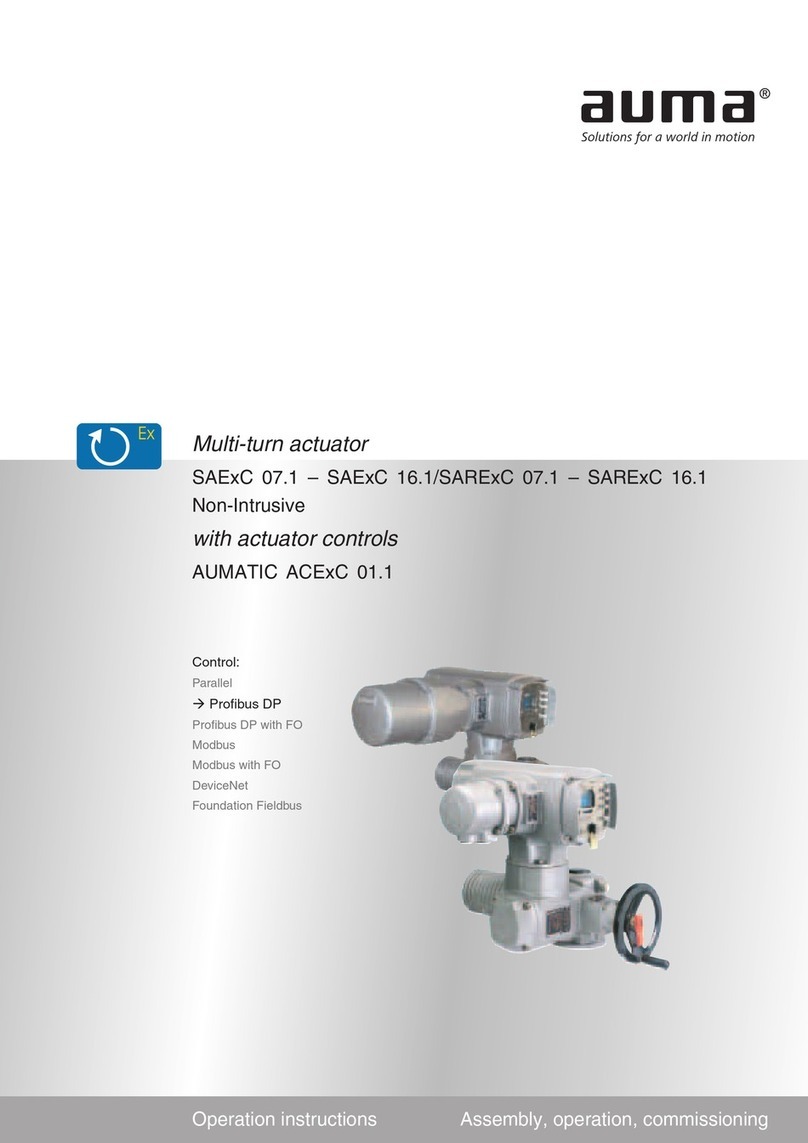
AUMA
AUMA SAExC 07.1 User manual
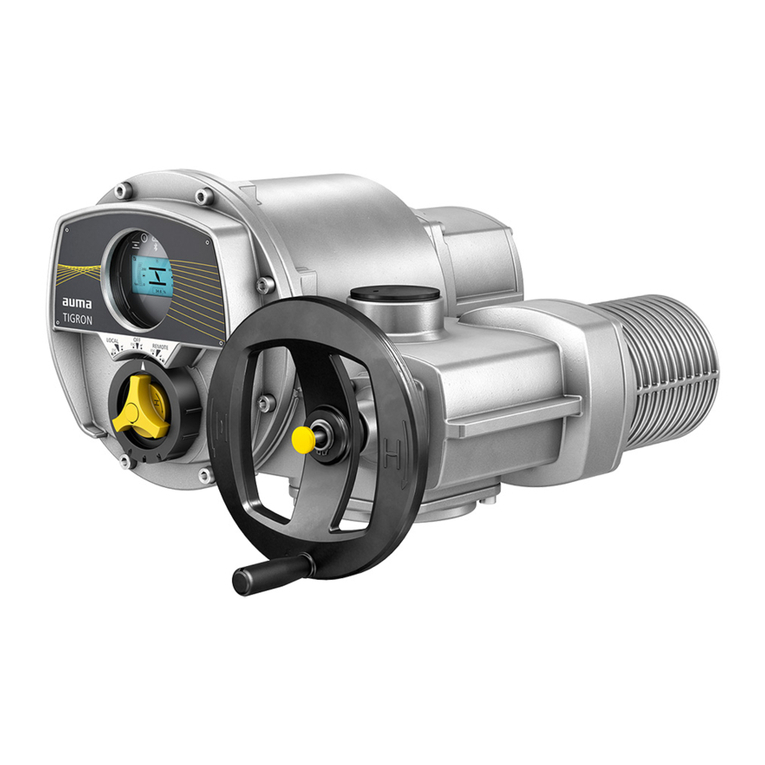
AUMA
AUMA TIGRON TR-M30X User manual
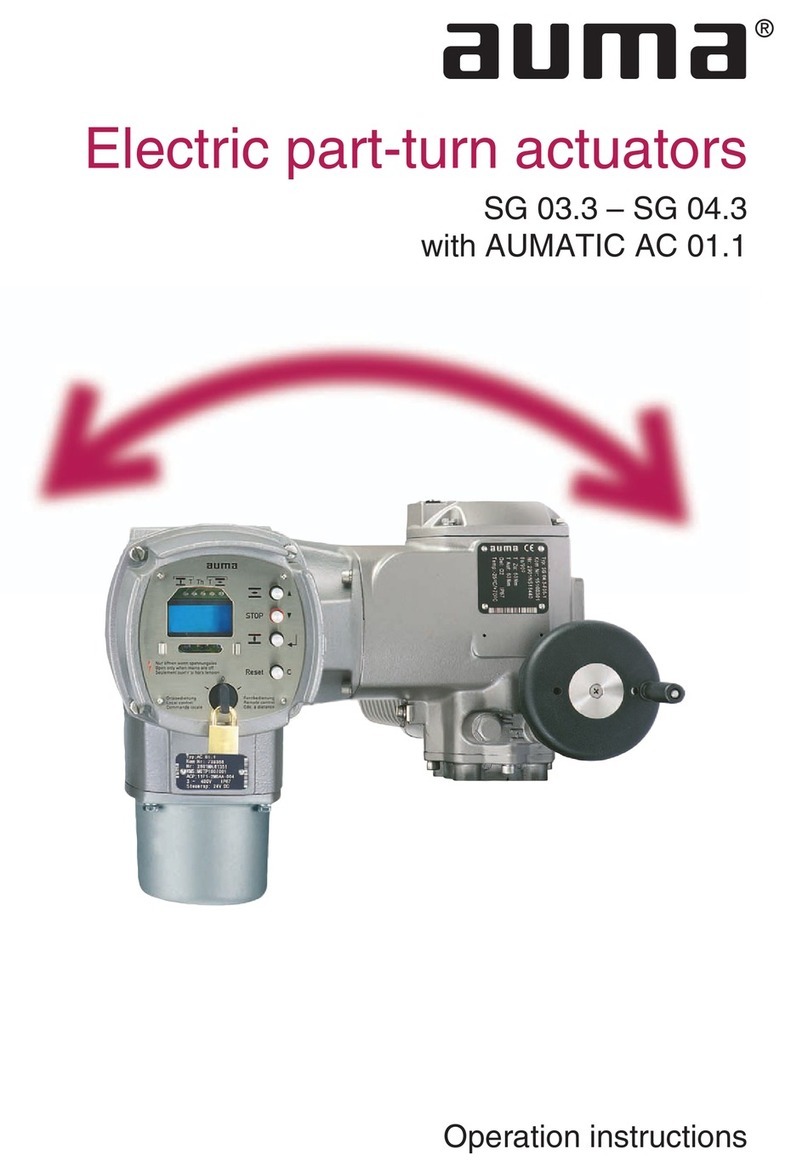
AUMA
AUMA SG 03.3 Series User manual
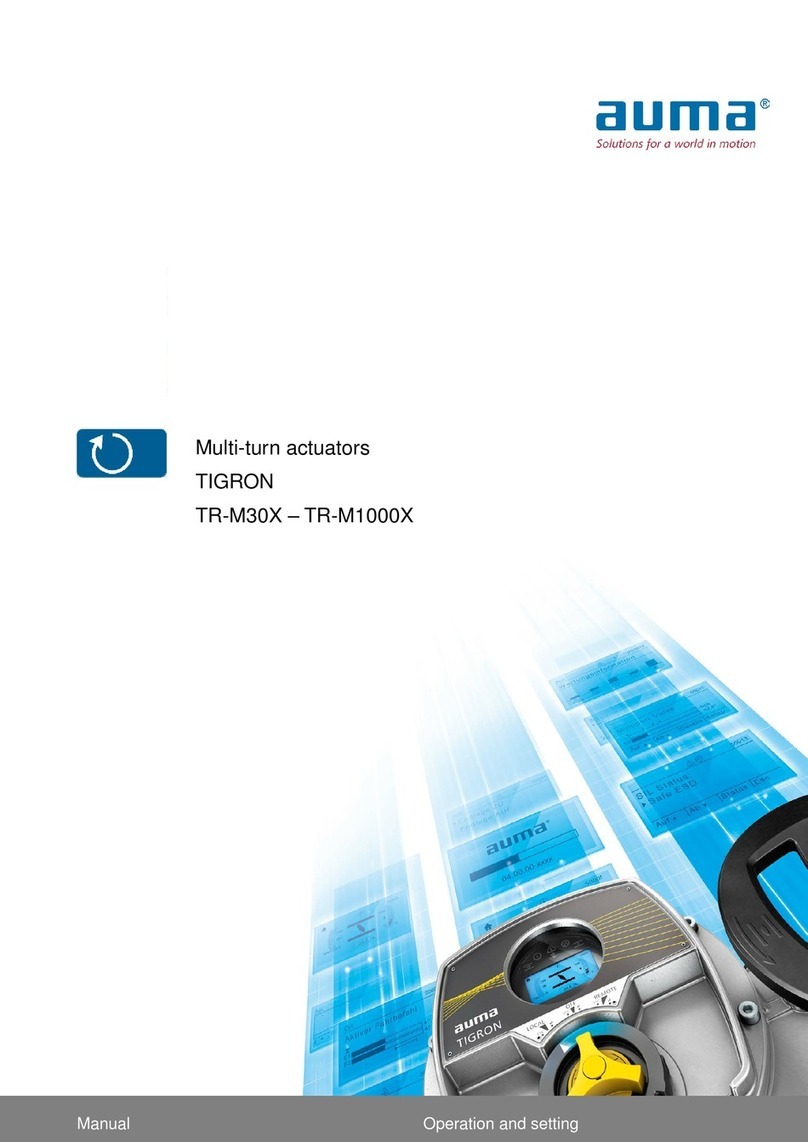
AUMA
AUMA TIGRON TR-M30X User manual
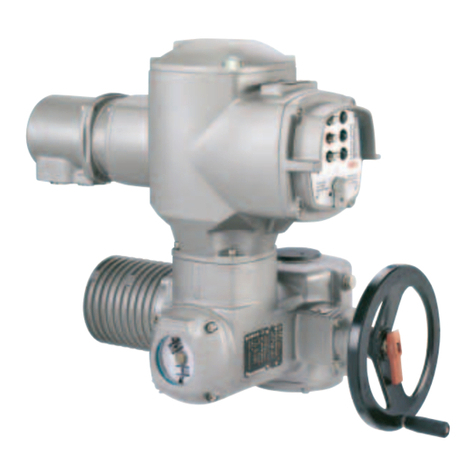
AUMA
AUMA SA 07.1 - SA 30.1 User manual
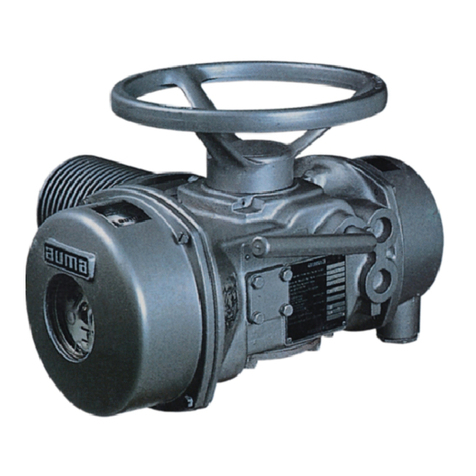
AUMA
AUMA SA3-SA100 User manual
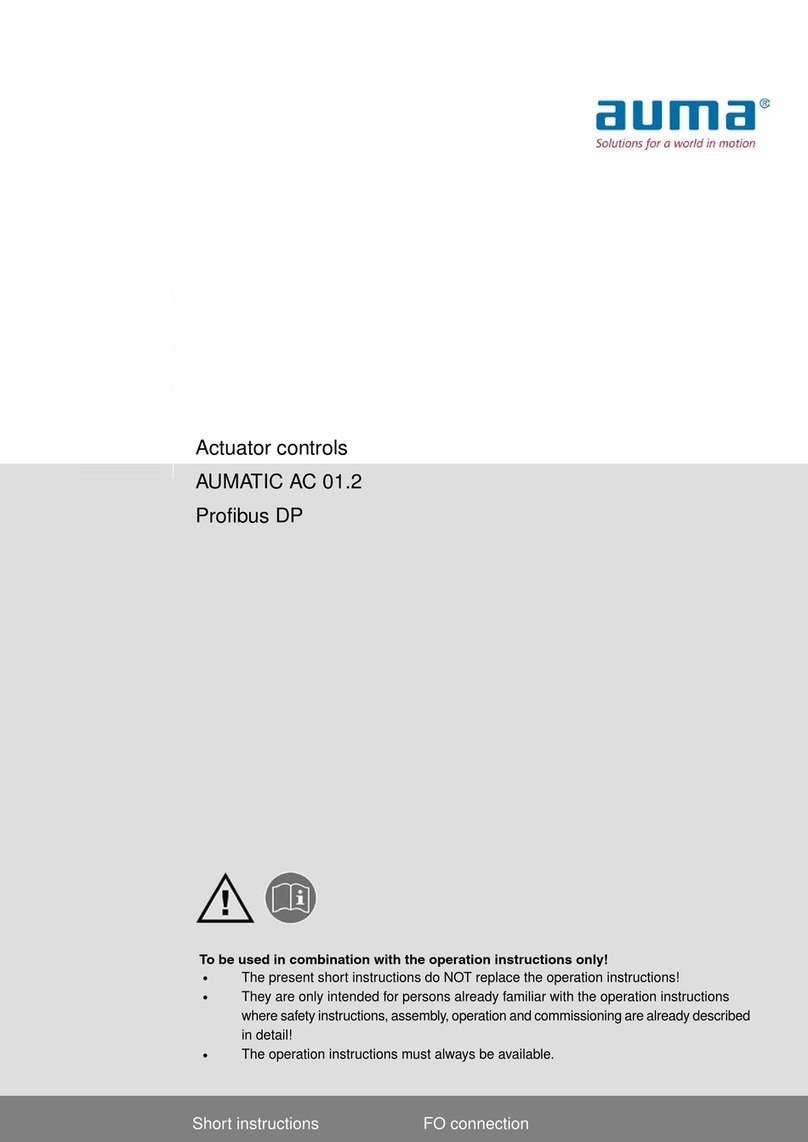
AUMA
AUMA AUMATIC AC 01.2 Manual
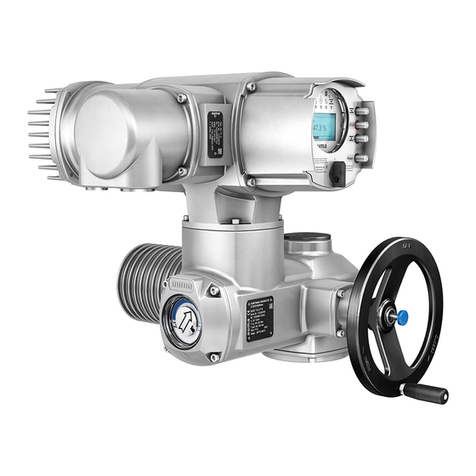
AUMA
AUMA SA 07.1 User manual

AUMA
AUMA SA Series User manual

AUMA
AUMA PROFOX PF-M100X User manual
